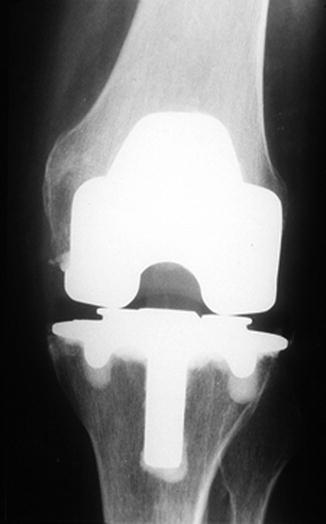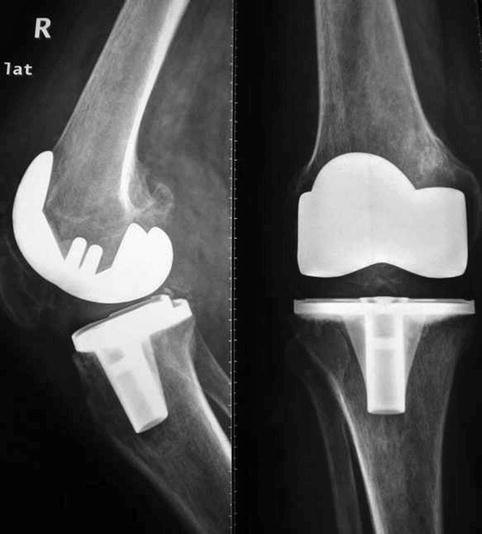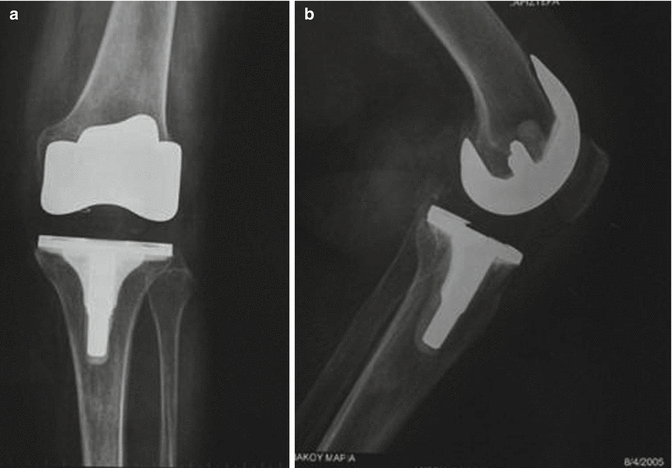Publication
Prosthesis (PCL-retaining)
Survivorship (Revision for any reason as end point except where noted)
5 years
10 years
≥12 years
Ritter (1995) [19]
AGC
98 %a
Malkani (1995) [20]
Kinematic-I
96.0 %
Weir (1996) [21]
Kinematic
92 %
87 % at 12 years
Abernethy (1996) [22]
Kinematic
94 %
88 %
Buehler (2000) [23]
Press-fit condylar
93.4 % at 9 years
Emerson (2000) [24]
AGC
95 %a
Van Loon (2000) [25]
Kinematic
90 %
82 % at 14 years
Gill (2001) [26]
Kinematic
99.4 %
98.2 %
92.6 % at 17 years
Sextro (2001) [27]
Kinematic
88.7 % at 15 yearsa
Pavone (2001) [28]
Total
91 % at 23 years
Condylar knee
Rodriguez (2001) [29]
Total
77 % at 21 years
Condylar knee
Berger (2001) [30]
Miller-Galante II
100.0 %
100.0 %
Laskin (2001) [31]
Genesis
96.0 %
Chen (2001) [32]
Genesis I
97.0 %
Ritter (2001) [33]
AGC
98.86 % at 15 yearsa
Fetzer (2002) [34]
Press-fit condylar
100.0 %
93.3 % at 12 years
Worland (2002) [35]
AGC
97 % at 14 years
Dixon (2005) [5]
Press-fit condylar
100.0 %
97.6 %
92.6 % at 15 years
Ma (2005) [36]
Total
83.2 % at 20 years
Condylar knee
Vessely (2006) [37]
Press-fit condylar
95.9 % at 15 years
Rodricks (2007) [38]
Press-fit condylar
91.5 % at 17 years
Barrington (2009) [39]
NexGen
99.0 %
97.0 %
Ritter (2009) [40]
AGC
97.8 % at 20 yearsa
Schwartz (2010) [41]
NexGen
98.7 %
97.7 %
Mouttet (2011) [10]
EUROP
99.0 %
97.8 %
95.8 % at 12 years
Chalidis (2011) [42]
Genesis I
96.69 % at 13.6 years
Lin Guo (2012) [43]
Press-fit condylar
92.5 % at 17 years
Huizinga (2012) [44]
AGC
87 % at 20 years

Fig. 13.1
Satisfactory AP radiograph of a Kinematic-KMS TKA at 18 years follow up is shown

Fig. 13.2
AP and lateral radiograph of a PFC CR TKA with satisfactory clinical outcome (despite varus placement of the tibial tray) at 14 years follow up is shown

Fig. 13.3
AP (a) and lateral (b) radiograph of a Genesis II CR TKA with satisfactory clinical outcome at 15 years follow up is shown
Vessely et al. [37] evaluated the long term survival of 1,000 consecutive PFC (press fit condylar) CR TKAs with a modular tibial component and a cemented all polyethylene patellar component. Approximately one third of revisions were for aseptic loosening or tibial polyethylene wear, while infection and periprosthetic fractures accounted for a substantial proportion of revisions and reoperations. They conclude that, in addition to ongoing efforts to minimize long term reoperation rates after TKA for mechanical failure, efforts should also concentrate on the prevention and effective treatment of prosthetic infection and periprosthetic fractures. Patient’s age at the time of surgery was the single most important determinant of implant survival. In those younger than 60 years, the 15 year survival free of revision for mechanical failure was 88.2 % (vs. 100 % for those over 80). In this study, survival at 15 years for revision for any reason was 95.9 similar to previously reported rates for CR PFC implants [5, 34]. Rodricks et al. [38] report the 14–17 year follow-up of the CR PFC in 160 consecutive TKAs. The overall survival rate was 91.5 % with revision for any reason as the endpoint and 97.2 % with revision for aseptic loosening as the endpoint. In this series, the patella was resurfaced in all cases and patella complications remained the most common problem (7 out of 11 revisions), supporting previous studies [23]. In a more recent study [43], survival over 17 years using the CR PFC implant was 92.5 %. The authors conclude that varus and valgus deformity of the unoperated contralateral knee and tibial varus deformity of the operated knee could be important factors related to arthroplasty failure. Huizinga et al. [44] report 87 % survival rate, with failure defined as revision for any reason including infection, after 15–20 year follow-up in a study group of 211 CR AGC TKAs in 177 patients. In all but three (after prior patellectomy), the patella was resurfaced. Most of the patellae (71 %) were resurfaced with a polyethylene dome patella; (29 %) were resurfaced with a metal-backed patella. The main reasons for failure were infection and failure of the metal backed patellar component. The use of metal backed patellar components was suspended in 1991, because of a high incidence of aseptic loosening observed in the study published by Ritter et al. [45]. These rates were also confirmed by Emerson et al. [24] who found a higher number of revisions in the metal backed patellar group at an average of 6.7 years after surgery. In another long-term follow-up study Ritter [40] reports a survival rate of 97.8 % after 20 years and attributes the success of the AGC implant to its relatively unconstrained articular geometry and the durability of a nonmodular metal backed tibial component with compression molded polyethylene. Ritter’s higher survival rate may be attributed to his correction for preoperative valgus deformity, which seemed to have a significant influence on survival. There are several other AGC outcome studies with shorter follow-up. Worland et al. [35] report 97 % survival at 14 years in a study group of 562 TKAs with revision for any reason as the end point. Emerson et al. [24] report survival rate of 95 % at 11.4 years in 62 TKAs with revision for any reason except infection. They only included living patients. Ritter et al. [19] report 98 % survival at 10 years with revision for any reason except infection. In a different study, Ritter et al. [33] report survival of 98.86 % at 15 years in 4583 TKAs with revision for any reason except infection.
There are few studies of other TKA designs with a follow up of more than 12 years. Total Condylar TKAs have been performed for more than 35 years and several long term studies [28, 29, 36] report outcomes at 20 years. These studies have shown survival, with revision for any reason as the end point, of 83.2 % at 20 years [36], 77 % at 21 years [29], and 91 % at 23 years [28], respectively. Mouttet et al. [10] in a prospective, one center study of a series of 121 cemented CR, fixed bearing tibial plate EUROP TKAs, reports an overall survival rate of 95.8 % at 12 years with revision for any reason as an end point. Chalidis et al. [42] showed a 96.69 % survival rate, at an average of 13.6 year follow up, in a study of 393 primary CR Genesis I TKAs with non-resurfaced patellae.
PS Versus CR TKAs
Both CR (Table 13.1) and PS (Table 13.2) TKAs have shown excellent long term results in terms of implant survival and patient satisfaction. Studies comparing the clinical outcomes of the two designs have produced a wide range of results; some show no difference [53–56], some have favored CR designs [9, 10, 18, 42, 57], and others have questioned the importance of the PCL [58–60]. It is well understood that so far different TKA designs have shown satisfactory outcomes independent of the retaining or sacrificing of the PCL. While no current research shows a significant difference in survival between CR and PS implants, it is not well understood why surgeons are divided into cruciate retainers and cruciate substituters. The debate still continues today regarding the long term outcomes CR and PS designs. Two recent meta-analysis reports [61, 62] have attempted to throw light on the current debate. Jacobs et al. [61] undertook a systematic literature review and found and studied eight randomized control trials. Two of them compared PCL retention against sacrifice, five against substitution and one had all three treatment options. The only statistical difference that could be found after analysis was that the PS group had 8° higher ROM when compared to the CR group. However, the study findings were heterogeneous at a level I2 of 67 %. Bercik et al. [62], in a more recent meta-analysis, studied a total of 12 studies which included 1265 procedures (660 with CR designs and 605 with PS designs) after applying strict criteria. For knee flexion, the results of the study demonstrated a statistically significant difference between CR and PS implants in favor of PS by 2.4°. In terms of heterogeneity, I2 was 40 % and no significant. ROM was also found to be statistically different, favoring PS implants by 3.33°, but heterogeneity was significant with an I2 of 70 %. One can argue that these differences in ROM and knee flexion, although statistically significant, may not have actual clinical importance for the patient. Thomsen et al. [63] found no association when comparing patients who had undergone bilateral TKA with high flex PS prosthesis in one knee and a standard CR prosthesis in the other knee. Besides the fact that the use of the high flex PS prosthesis resulted in significantly increased flexion compared to the standard CR prosthesis, this did not affect parameters such as pain and patient satisfaction. Two other studies performed by Padua et al. [64] and Ritter et al. [65] also found no significant correlation between increased postoperative flexion, either active or passive, and patient satisfaction.
Table 13.2
Review of the literature
Publication | Prosthesis (Posterior cruciate ligament substituting) | Survivorship | |
|---|---|---|---|
Scuderi (1989) [46] | Insall Burstein | All poly tibia | 97.34 at 10 years |
Metal back tibia | 98.75 at 7 years | ||
Stern (1992) [1] | Insall Burstein | All poly tibia | 94 at 13 years |
Colizza (1995) [47] | Insall Burstein | Metal back tibia | 96.4 at 11 years
Stay updated, free articles. Join our Telegram channel
Full access? Get Clinical Tree
 Get Clinical Tree app for offline access
Get Clinical Tree app for offline access

|




